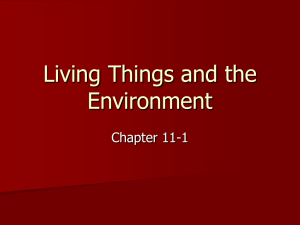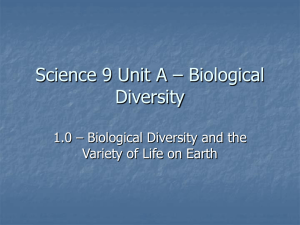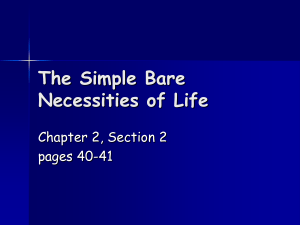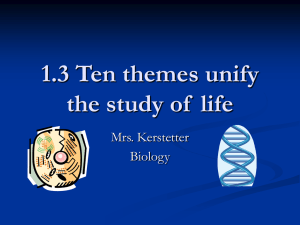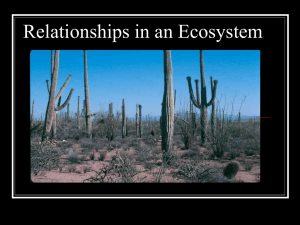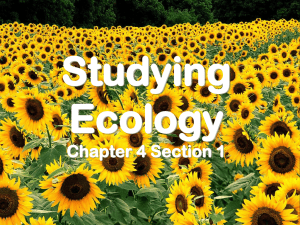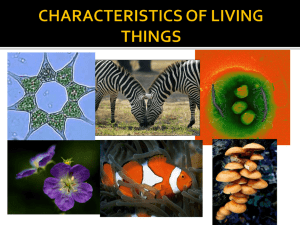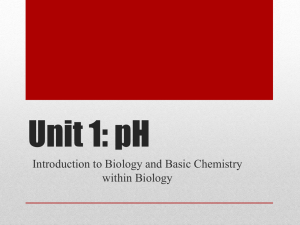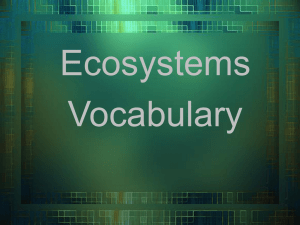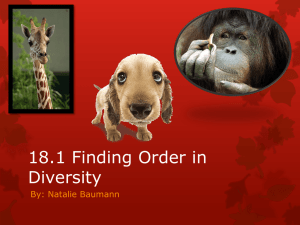Biosphere Notes - St Thomas Aquinas RC Secondary School
advertisement
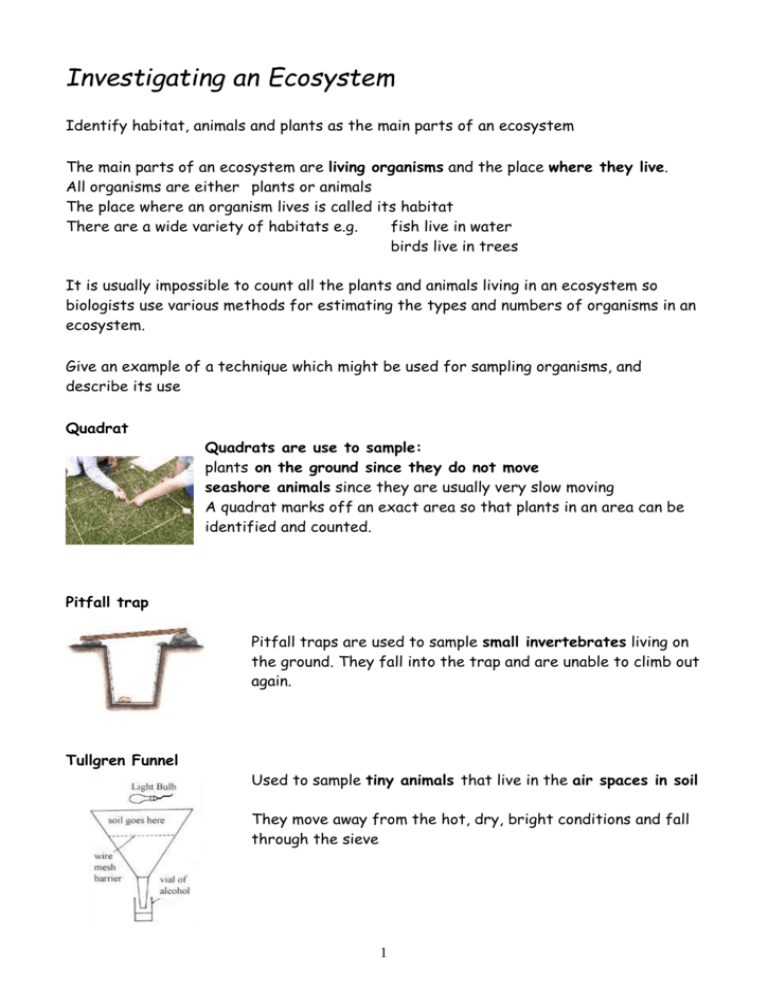
Investigating an Ecosystem Identify habitat, animals and plants as the main parts of an ecosystem The main parts of an ecosystem are living organisms and the place where they live. All organisms are either plants or animals The place where an organism lives is called its habitat There are a wide variety of habitats e.g. fish live in water birds live in trees It is usually impossible to count all the plants and animals living in an ecosystem so biologists use various methods for estimating the types and numbers of organisms in an ecosystem. Give an example of a technique which might be used for sampling organisms, and describe its use Quadrat Quadrats are use to sample: plants on the ground since they do not move seashore animals since they are usually very slow moving A quadrat marks off an exact area so that plants in an area can be identified and counted. Pitfall trap Pitfall traps are used to sample small invertebrates living on the ground. They fall into the trap and are unable to climb out again. Tullgren Funnel Used to sample tiny animals that live in the air spaces in soil They move away from the hot, dry, bright conditions and fall through the sieve 1 Water net Used to catch pond animals that are quickly transferred to screw-top jars containing pond water Beating stick and tray Tap tree branches with the stick and catch small animals in the tray Identify a possible source of error that might accompany a sampling technique and explain how it might be minimised Technique Quadrat Pitfall trap Possible error Plants might be wrongly identified or counted The quadrat might not be placed randomly Badly set traps may catch no animals some animals may get eaten by other animals before they are examined results not reliable Way of minimising the error Take more samples to make the results more reliable Place the quadrat randomly Traps should be level with the ground Trap should be examined often set more traps Identify two abiotic factors An abiotic factor is a non-living factor (often related to the weather) which can affect the distribution of organisms in an ecosystem. Some abiotic factors are: Soil pH The Sun provides light Temperature – it cant be too hot or cold Moisture Oxygen is needed to release energy from aerobic respiration 2 Give an example of a technique which might be used to measure an abiotic factor and describe its use Abiotic factors can be measured using meters Light meters measure light intensity. The meter is held at the soil surface and pointed in the direction of maximum light intensity, the reading on the meter is then noted. Soil moisture meters and soil pH meters are used by pushing the probe into the soil and reading the meter. Temperature is measured using a thermometer. The bulb of the thermometer is placed into the substance whose temperature is to be taken. Identify a possible source of error that might accompany a measurement technique and explain how it might be minimised Standing in front of a light meter can cause an error in the reading as this will block the light. When comparing light intensities of different ecosystems, you should ensure that readings are taken at the same time of day, in similar weather conditions . This will allow a fair comparison. You must wipe a moisture meter probe in between sampling different areas so that you remove moisture from a previous measurement before making the next measurement. Try to use a meter which is as accurate as possible. For all of the meters you could improve the reliability of your results by repeating the experiment. 3 State the effect an abiotic factor has on the distribution of an organism Green plants are not usually found where the light intensity is too low. Most organisms do not like too hot or too cold temperatures. Most land organisms are not found in very wet or very dry areas. Explain possible mechanisms by which abiotic factors might influence the distribution of organisms Extremes of temperature affect the numbers of organisms found in ecosystems. Many organisms cannot survive extremes of temperature. Many green plants are not found in areas with low light intensity as too little light limits the rate of photosynthesis. Most land organisms are not found in areas which are too dry as they would become dehydrated. Animals and plants are not found in very wet soil because they may drown. How it works Describe what is meant by habitat, population, community and ecosystem An ecosystem is a natural biological unit made of living (biotic) and non-living (abiotic) parts. Ecosystem = community + habitat A habitat is the place where an organism lives. A community is made up of all the plant and animal populations living in the ecosystem. A population is a group of organisms belonging to the same species. Consider a freshwater ecosystem There are a number of different habitats e.g. the riverbed, the pondweed, the water surface. There are members of the community e.g. pondweed, plankton and fish There are a number of different populations e.g. plankton, pondweed 4 Describe what is meant by producer and consumer Producers make their own food by photosynthesis. All producers are green plants. They trap light energy from the Sun and convert it into chemical energy. All animals and non-green plants cannot make their own food. They obtain the energy they need by eating green plants or animals that have eaten green plants. These organisms are consumers. There are 3 types of animal consumer: carnivores eat other animals e.g. lion herbivores eat plants e.g. sheep omnivores eat plants & animals e.g. humans 5 Give an example of both a food chain and a food web A food chain is a diagram showing feeding relationships between several living things. Arrows in a food chain point from food to feeder. All of the energy in a food chain or web comes from the Sun. Grass - - - - - - - - - > rabbit - - - - - - - - - - - - >fox The producer is the grass. The consumers are the rabbits and fox There are 2 types of consumer primary and secondary. Primary consumers eat producers. Secondary consumers eat primary consumers. Predator and prey Predators are animals that hunt other animals. Victims of predators are called prey. e.g. lion and antelopes, foxes and rabbits etc. A food chain rarely exists in isolation as there are normally a number of consumers eating the producer. In turn the consumers are preyed upon by a number of predators. More complicated diagrams showing interconnected food chains are called food webs. Explain possible effects of the removal of one species on the remaining organisms in a food web If one species is lost from a food web all others will be affected. If all of the trees disappear there will be no food for the mushrooms and caterpillars so they will die out. The animals which eat the mushrooms will also die out. The mice will survive as they will eat more of their other foods to replace the caterpillars. This will affect the number of other organisms in the food web. 6 State that the arrows in a food web indicate the direction of energy flow In a food chain energy is transferred from food to feeder. State 2 ways in which energy can be lost from a food web Only about 10% of the available energy is passed on at each stage of a food chain. Energy is lost through: Movement Heat Undigested food Explain what is meant by the terms pyramid of numbers/biomass Consider the following food chain existing in a field 1 square mile in size: Grass rabbit fox As you go up the food chain the size of the organism usually increases (except in food webs where the producer is a tree). The species present in the highest number is usually the producer (except when the producer is a tree) It is possible to write a food chain as a pyramid. It is called a pyramid because there are fewer organisms at successive levels. As you go up the pyramid the number of organisms at each level decreases. An unusual pyramid of numbers 7 A more accurate idea of the quantity of animal and plant material at each level of the pyramid is obtained by weighing all of the organisms at each level. This is called the biomass. As you move along a food chain the biomass decreases State that the growth rate of a population depends on birth and death rates Birth rate is the number of live organisms born in a certain period of time. Death rate is the number of organisms that die every year. The growth rate depends on both the birth rate and the death rate. The population of India is increasing as the birth rate is higher than the death rate. If the death rate was higher than the birth rate then the population size would decrease. State three factors which can limit the growth of a population Some factors limit the size of populations: lack of food causes death in famines Lack of water animals are prey to predators disease e.g. measles, influenza lack of space toxic waste produced by the population build up and poison future generations 8 Describe the growth curve of a population under ideal conditions Under ideal conditions there are no limiting factors and the population explodes. Explain the growth curve of a population under ideal conditions A small number of organisms colonise a new environment. Growth is slow because the population is small. Then the numbers increase dramatically in the absence of limiting factors. The population stops growing because of a shortage of resources or the accumulation of toxic waste. State that competition occurs when organisms have a need for the same resources Plants might compete for: space light water minerals and other nutrients Animals compete for: food e.g. predators might compete for the same prey living space partners to mate with 9 Describe some effects of competition ‘Weaker’ members of the population die before reproductive age. Stronger more successful competitors survive and become the parents of the next generation. Explain the importance of nutrient cycles to the organisms of an ecosystem Living things need nutrients to stay alive and grow. Nutrients are recycled. Decomposer organisms release nutrients from dead bodies back into the environment. If there were no decomposers nutrients would run out. Other living things would die if there were no decomposers. Nutrients such as carbon and nitrogen must be recycled between living organisms, the air and the soil so that organisms in an ecosystem will continue to have the necessary elements to reproduce and grow. 10 Describe the sequence of processes in the nitrogen cycle Living things need nitrogen to make protein. Lightning is a natural method of adding nitrates to the soil. 11 Control and Management State that pollution affects air (A), fresh water (W), sea (S) and land (L) Pollution occurs when the presence of a substance (the pollutant) causes harm to organisms, looks unsightly or causes damage to buildings. The 4 ecosystems that are mainly affected by pollution are Air Land Sea Fresh water State that the main sources of pollution are domestic, agricultural and industrial, giving an example of a pollutant from each The main three source of pollution are domestic - the home e.g. detergents (W), household waste (L) and sewage (W) agricultural - the farm e.g. fertilisers (W) and pesticides (W) industrial - industry e.g. oil (S), sulphur dioxide (A), radiation (S) and heavy metals (L) Explain an adverse effect of using fossil fuels and nuclear power as energy sources Fossil fuels: coal, oil and gas Most of our energy comes from power stations which burn fossil fuels to produce electricity. Fossil fuels are non-renewable and are running out. They take millions of years to form. Burning coal produces soot. Soot covers leaves and blocks sunlight. It also blocks the stomata so that carbon dioxide cannot enter the leaf. Both of these affect photosynthesis. Soot also makes buildings dirty 12 Burning of fossil fuels produces large amounts of gases: carbon dioxide and sulphur dioxide. Carbon dioxide causes global warming which is causing rising sea levels and changing weather patterns. Sulphur dioxide + water (in atmosphere) Acid rain When acid rain falls it decreases the pH. This kills trees, plants and animal life in lakes. Nuclear Power Energy comes from power stations driven by nuclear reactors. The great promise of nuclear fuel is that it provides a plentiful source of energy. Although it is not cheap its raw material is very common in the Earth’s crust and is unlikely to ever run out. Problems of nuclear energy At 1.24 AM on the 26th of April 1986 there was an explosion at the Chernobyl nuclear power plant. Scientists predict up to 75,000 people living far outside the area will die from cancer as a result. Waste is radioactive for many years and is difficult to get rid of safely. If it is not disposed of carefully it can pollute air and water and accumulate in food chains where man is often the final consumer. This can increase the incidence of different types of cancer. The nuclear v. fossil fuel debate Some people claim that nuclear fuel is better than fossil fuels. They say that it is safer produces less waste the only alternative to fossil fuel less damaging to the environment than fossil fuel power stations 13 Give an example of one way in which pollution may be controlled The environment can be damaged in many other ways. Chemicals in aerosol cans reduce the protective ozone layer of the atmosphere that results in higher exposure to dangerous UV rays. Car exhausts produce poisonous carbon monoxide and lead that can damage us and other organisms. Raw sewage released into rivers kills fish and other organisms. Pollution could be controlled in a number of ways: Damage to the ozone layer could be decreased by using a less harmful propellant gas in aerosols Acid rain could be reduced by reducing the amount of sulphur dioxide released by power stations Brain damage caused by lead could be stopped by using unleaded petrol Less dead fish would be found in rivers by improving treatment of sewage before release into rivers State that organic waste is a food source for micro-organisms Organic waste is the unwanted products of living organisms. Raw sewage is a rich source of organic waste and must be treated carefully before being released into rivers. If a sewage works is overloaded water can become polluted by organic waste. Bacteria will feed on the organic material, grow and multiply. Describe the effect of increased numbers of micro-organisms on the oxygen available to other organisms If there are more micro-organism they will use up the available oxygen. This means that there is less oxygen for other organisms e.g. fish. This will cause them to die. 14 Explain the relationship between level of pollution with organic waste, numbers of micro-organisms, oxygen concentration and numbers of species An increase in organic pollution causes a large increase in the numbers of microorganisms present in water. As they grow the bacteria use up oxygen from the water around them. This can cause the death of other aquatic (water living) organisms that require oxygen to survive. Explain what is meant by “indicator species” Some organisms can only grow under certain environmental conditions. These organisms are called Indicator species because their presence or absence in an area shows how polluted or clean the area is. Fresh-water species The species present in fresh-water indicate the varying oxygen concentrations found in a river polluted with organic waste. Indicators of air pollution Different types of lichen differ in their sensitivity to sulphur dioxide (SO2) gas and can be used to indicate the degree to which an ecosystem’s atmosphere is polluted by this harmful gas. Indicator species present Crusty lichens only Crusty and leafy lichens Crusty, leafy and some shrubby lichens Crusty, leafy, shrubby and hairy lichens 15 SO2 concentration (level of atmospheric pollution) High Medium Low Very low/zero Give 2 examples of poor management of natural resources and suggest possible improvements Overuse of fertilisers and pesticides Problems Excess fertilisers are washed into rivers and lakes and cause pollution. Pesticides that do not decompose naturally enter food chains and accumulate, causing harm to the final consumer. Solution Use as little fertiliser as possible especially on land near waterways. Develop biodegradable pesticides or use natural ones e.g. one animal to eat another Overgrazing of grassland (developing countries) Problems Overgrazed plants die and no longer retain water in the soil. Land turns into a desert. Solution Provide economic aid to plant shelter beds of trees and resilient grass cover. Describe how the effect of poor management of natural resources can produce problems In the third world lack of technology and farming know-how has led to soil erosion and desertification causing crop failure and famine. Lack of fertilisers and equipment mean that farmers in the Amazon destroy more and more rainforests when the soil they are farming becomes exhausted. Explain how components of an ecosystem are controlled in either agriculture or forestry When growing crops a farmer is creating and controlling an artificial ecosystem. The farmer uses: Fertilisers- to keep the soil fertile Pesticides - to kill pests and prevent diseases Herbicides - to kill any weeds that would otherwise compete with the crop for space and nutrients 16
